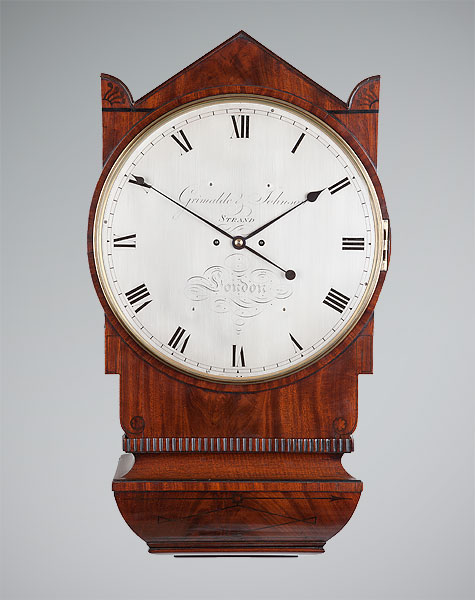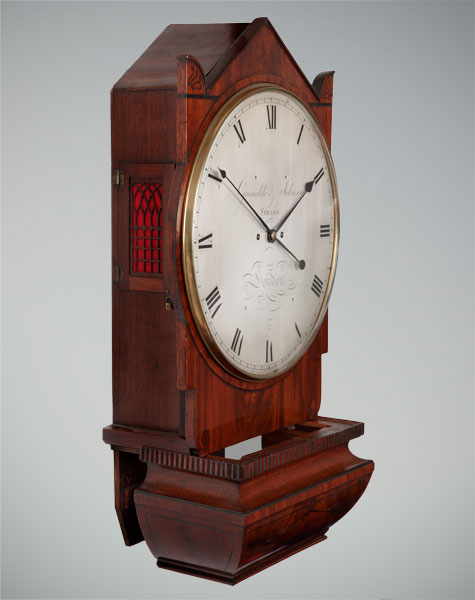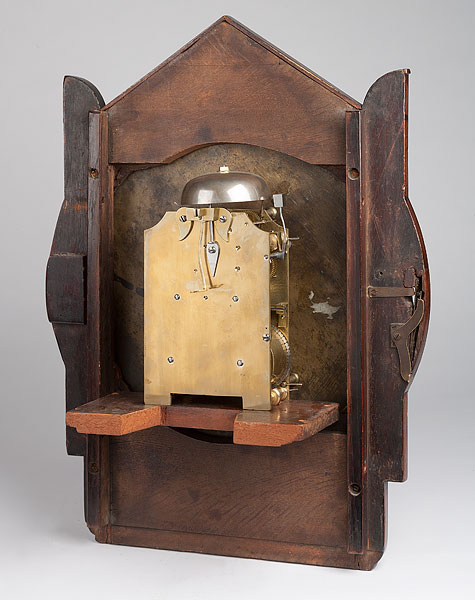[javascript protected email address]

Grimalde & Johnson, London



Circa 1815
Sold
27¾ inches high
A very fine and rare mahogany, ebony and holly inlaid striking wall clock. CASE The beautifully proportioned solid case is surmounted by an architectural pediment flanked by palmette acroteria above an ebony line-inlaid border. Beneath the dial is a mahogany panel inlaid either side with a stylized Grecian handle with trailing flowerheads beneath. The sides are set with two hinged doors with pierced mahogany tracery frets. The sarcophagus-shaped base is formed as a sliding bracket with geometric ebony line inlay to the front and sides with a mahogany ripple moulding above. DIAL The 14 inch diameter silvered brass dial is signed Grimalde & Johnson STRAND London within a Roman chapter ring with outer minute track and delicate blued steel spade hands – enclosed within a fine brass bezel covered with a convex glass. MOVEMENT The movement has thick brass shouldered plates joined by five large baluster pillars, the two wheel trains have twin chain fusees and spring barrels; the going train has the original anchor escapement and the strike train operates on a rack system with hour strike on a bell suspended above the movement plates. The movement is secured to a mahogany seatboard, which rests on mahogany cheeks in the sides of the case. NOTES Grimalde & Johnson were in partnership between 1809-1825. They are perhaps best known for their small well-proportioned ebonised table clocks which were made in very limited numbers. This possibly unique clock is thought to be the only known wall clock to exist by Grimalde & Johnson. The very lovely architectural case has admirable proportions and the sliding sarcophagus-shaped bracket at the base of the case is a neat and clever feature reminiscent of the earlier hooded wall clocks by such makers as John Ellicott and Alexander Cumming. GEORGE BULLOCK The case of this clock has a very distinct Greco-gothic theme epitomised by the architectural pediment flanked by acroteria, the line-inlaid Greek handles beneath the dial and the sarcophagus-form bracket in the base. This Grecian architectural style is typical of the work of the cabinet-maker George Bullock (d. 1818). In 1804 George Bullock went into business with a looking-glass maker called William Stoakes. They advertised themselves as "Cabinet Makers, General Furnishers and Marble Workers", trading from a showroom called the "Grecian Rooms" in Bold Street, Liverpool. At about this time, a guide to Liverpool described his Grecian Rooms as offering "an extensive assortment of elegant and fashionable furniture; as also, statues, figures, tripods, candelabra, antique lamps, sphinxes, griffins, &c., in marble, bronze, and artificial stone." Following the success of his company he moved to London in 1813, he exhibited at the Royal Academy in London and was the President of the Liverpool Academy in 1810 and 1811. He also undertook several famous commissions, perhaps the most notable being for the government, to provide furnishings for Napoleon''s home in exile on St. Helena.
